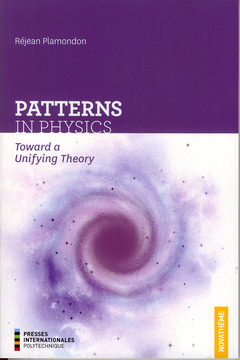Patterns in physics Toward a unifying theory Novathème Series
Auteur : PLAMONDON Réjean

Foreword
Acknowledgements
CHAPTER 1
Introduction
CHAPTER 2
The origin of Newton's law
Putting general relativity into a probabilistic context. Principle of interdependence. The emergence of Newton's law of gravitation. A symptotic congruence.
CHAPTER 3
The intrinsic link between the speed of light, the gravitational and the Boltzmann constants
The numerical value of c and the Pioneer 10/11 anomaly. The numerical value of G, of the Boltzmann constant, the electron and proton masses and the Avogadro number.
CHAPTER 4
The symmetric metric, the Sun's mass, the Hubble constant and the cosmic microwave background
The spherically symmetric metric. Investigating the solar. system. Modelling a general star. An extendable model. The Hubble constant. Cosmic microwave background. The black hole and gravitational collapse.
CHAPTER 5
A detailed study of the symmetric metric
The symmetric metric and the field equations. The geodesics. The motion of massive particles. The motion of photons. Investigating a stellar system interior.
CHAPTER 6
The axisymmetric metric, dark matter, dark energy and the cosmological constant
An axisymmetric solution. Investigating the solar system. A galaxy model. Dark matter. A Universe model. Cosmological constant and dark energy.
CHAPTER 7
A detailed study of the axisymmetric metric
The axisymmetric metric. The geodesics. The equatorial orbits. The circular equatorial orbits. The radial equatorial geodesics.
CHAPTER 8
The Planck constant, the electric charge and the emergence of Coulomb's law
The convergence error and the Planck constant. The electric charge, the permittivity of the vacuum and a link with Coulomb's law. The permeability of vacuum. The Heisenberg
principle. A potential pathway to quantum field theory. The latent existence of magnetic monopoles.
CHAPTER 9
The weak and strong interactions, the fine structure constant and the neutrinos
The three residual interactions. The weak and strong fields and potentials. The fine structure constant. Energy conservation and neutrinos.
CHAPTER 10
General conclusion
Appendix A Generalizing to other systems of units
Appendix B Christoffel symbols and Riemann tensor
for the symmetric metric
Appendix C Unsuccessful attempts at offset removal
Appendix D Axisymmetric energy equation
References
Biography
Index
This book aims to lay out some groundworks from which a theory for bridging the gap between quantum mechanics and general relativity could be built. It should excite the curiosity of many scientists interested in the search for new patterns that could lead to the unification of physics, more specifically graduate and undergraduate students, postgraduates, researchers, engineers and academics working in the area of fundamental and theoretical physics, quantum mechanics, general relativity, astrophysics and cosmology.
Date de parution : 07-2012
Ouvrage de 201 p.
15x23 cm
